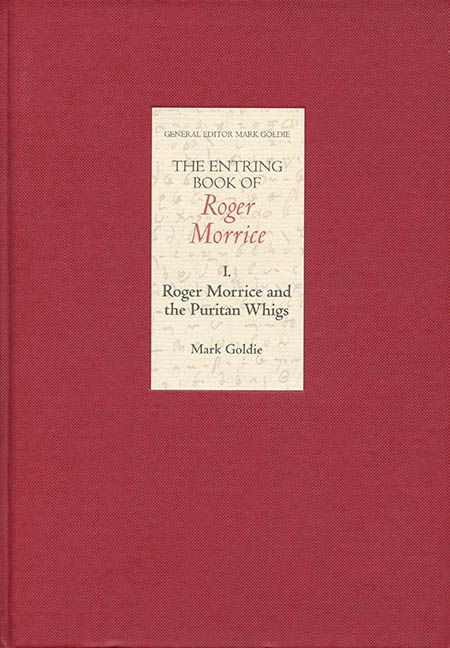Book contents
- Frontmatter
- Contents
- List of Illustrations
- Foreword
- Preface
- Notes on the Editors
- Acknowledgements
- Reader's Guide
- Abbreviations
- Genealogical Tables
- Maps
- Maps
- 1 Politics and Religion in the Era of the Entring Book
- 2 Roger Morrice: Fragments of a Life
- 3 The Text of the Entring Book
- 4 Puritan Whigs
- 5 Country Whigs
- 6 Middle-Way Religion
- 7 The History of the Puritans
- 8 Epilogue: The Entring Book and the Historians
- Appendices
- Bibliography
- Index
- Frontmatter
- Contents
- List of Illustrations
- Foreword
- Preface
- Notes on the Editors
- Acknowledgements
- Reader's Guide
- Abbreviations
- Genealogical Tables
- Maps
- Maps
- 1 Politics and Religion in the Era of the Entring Book
- 2 Roger Morrice: Fragments of a Life
- 3 The Text of the Entring Book
- 4 Puritan Whigs
- 5 Country Whigs
- 6 Middle-Way Religion
- 7 The History of the Puritans
- 8 Epilogue: The Entring Book and the Historians
- Appendices
- Bibliography
- Index
Summary
THE Entring Book is a chronicle of English history, and of Scottish, Irish, and European history in their connection with England, at a time of trauma in the political and religious life of the nation. It spans the years 1677 to 1691 and unfolds a crisis that began with fears about the conduct of King Charles II, culminated in the overthrow of his brother King James II in the ‘Glorious Revolution’ of 1688, and achieved partial resolution in the joint reign of King William III and Queen Mary II. Its author, Roger Morrice (1628–1702), was a Puritan clergyman turned confidential reporter and agent for a group of senior Whig politicians. He was remarkably well connected and well informed, a confidential go-between, a conduit for public business, and a barometer of public opinion. Above all, he was a voracious gatherer of news and a tenacious recorder of what he heard and saw. He was passionately committed to the defeat of absolutism in government and intolerance in religion, but he conceived of those principles from a profoundly Protestant and Dissenting standpoint. His narrative emerges as a record of the tribulations of a godly people, and of the manoeuvres of courtiers, parliamentarians, and churchmen, in the face of the threat from Roman Catholicism, the exorbitant authority of the crown, and oppression by the Church of England.
The Entring Book is a rich source for much else besides, valuable for what it reveals not only about politics and religion but also about manifold aspects of Restoration society, its social structure and public spaces, its institutions and personalities, its theatres and law courts, its manners and mores. It has much to say about military and colonial affairs, about foreign relations, and European warfare. It is informative about printing, bookselling, and the control of the press, as well as about patterns of communication, gossip, and rumour. It provides an intricate account of metropolitan life and urban development in a London rising phoenix-like from the ruins of the Great Fire. It offers closely-observed accounts of spectacle, ceremony, celebration, and demonstration. There are descriptions of firework carnivals, lord mayor's shows, ‘masquerades’, and puppet shows; fires and hurricanes, duels and executions, murders and suicides.
- Type
- Chapter
- Information
- The Entring Book of Roger MorriceRoger Morrice and the Puritan Whigs, pp. xiii - xvPublisher: Boydell & BrewerPrint publication year: 2007

